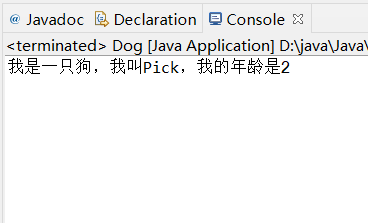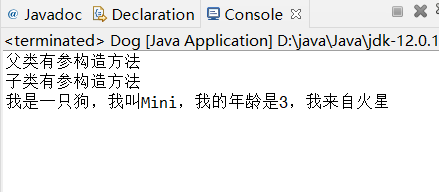1.继承示例:
//动物类 public class Animal { private String name; //姓名 private int age; //年龄 public String getName() { return name; } public void setName(String name) { this.name=name; } public int getAge() { return age; } public void setAge(int age) { this.age = age; } public void say() { System.out.println("我是一个动物,我叫"+this.getName()+",我的年龄是"+this.getAge()); } }
//定义Dog类,继承Animal类 public class Dog extends Animal { // 重写父类的say()方法 public void say() { System.out.println("我是一只狗,我叫" + this.getName() + ",我的年龄是" + this.getAge()); } public static void main(String[] args) { Dog dog = new Dog(); dog.setName("Pick"); dog.setAge(2); dog.say(); } }

2.生成get、set方法的快捷方式:Alt+Shifl+s
3.对象实例化以及super关键字示例
//定义Dog类,继承Animal类 public class Dog extends Animal { private String home; // 地址 // 无参构造方法 public Dog() { super(); System.out.println("子类无参构造方法"); } // 有参构造方法 public Dog(String name, int age, String home) { super(name, age); this.home = home; System.out.println("子类有参构造方法"); } public String getHome() { return home; } public void setHome(String home) { this.home = home; } // 重写父类的say()方法 public void say() { System.out.println("我是一只狗,我叫" + this.getName() + ",我的年龄是" + this.getAge() + ",我来自" + this.getHome()); } public static void main(String[] args) { Dog dog = new Dog("Mini", 3, "火星"); dog.say(); } }

4.定义静态常量:static final double PI=3.1415926